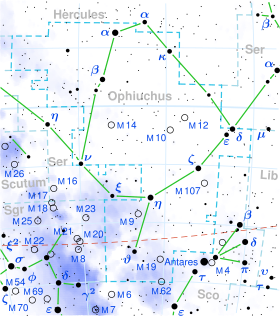| Observation data Epoch J2000 Equinox J2000 | |
|---|---|
| Constellation | Ophiuchus |
| Right ascension | 16h 32m 08.19983s[1] |
| Declination | −21° 27′ 59.0120″[1] |
| Apparent magnitude (V) | 4.45[2] (4.44 – 4.51)[3] |
| Characteristics | |
| Evolutionary stage | main sequence[4] |
| Spectral type | ApSrEuCr[5] or A2 Vp(SrCrEu st, K sn)[4] |
| U−B color index | +0.13[6] |
| B−V color index | +0.130±0.002[2] |
| Variable type | α2 CVn[3] |
| Astrometry | |
| Radial velocity (Rv) | +2.5±0.7[7] km/s |
| Proper motion (μ) | RA: +21.12[1] mas/yr Dec.: +35.26[1] mas/yr |
| Parallax (π) | 19.34 ± 0.21 mas[1] |
| Distance | 169 ± 2 ly (51.7 ± 0.6 pc) |
| Absolute magnitude (MV) | 0.88[2] |
| Details[8] | |
| Mass | 2.25+0.13 −0.35 M☉ |
| Radius | 2.97±0.19 R☉ |
| Luminosity | 34.7±1.6 L☉ |
| Surface gravity (log g) | 3.85+0.65 −0.69 cgs |
| Temperature | 8,150±250 K |
| Metallicity [Fe/H] | −0.47[9] dex |
| Rotation | 2.3205±0.0002[10] |
| Rotational velocity (v sin i) | 32.2±1.4 km/s |
| Age | 860+150 −110 Myr |
| Other designations | |
| Database references | |
| SIMBAD | data |
Omega Ophiuchi, which is Latinized from ω Ophiuchi, is a single,[12] variable star in the equatorial constellation of Ophiuchus, located just to the north of the ecliptic near the western constellation border with Scorpius. It is a white-hued star that is faintly visible to the naked eye with an apparent visual magnitude that fluctuates around 4.45.[2] Parallax measurements indicate it lies at a distance of about 168.6 light years from the Sun.[1] It is drifting further away with a radial velocity of +2.5 km/s.[7]
This object is an Ap star with a stellar classification of ApSrEuCr,[5] displaying strong abundance anomalies of the elements strontium, europium, and chromium. Abt and Morrell (1995) found a class of A2 Vp(SrCrEu st, K sn),[4] showing further an A-type main-sequence star with a Ca II line (single-ionized calcium) having both sharp and broad components. It is an Alpha2 Canum Venaticorum variable, with its brightness ranging from magnitude 4.44 down to 4.51 over a period of 2.99 days.[3] A strong magnetic field has been measured on the surface.[10] A 2022 study detected no companion stars, but found an anomaly in its proper motion, suggesting it is potentially orbited by a compact star such as a white dwarf.[13]
Omega Ophiuchi is around 860 million years old with a projected rotational velocity of 32.2 km/s[8] and a rotation period of 2.3 days.[10] It has 2.3 times the mass of the Sun and 3.0 times the Sun's radius. The star is radiating 35 times the luminosity of the Sun from its photosphere at an effective temperature of 8,150 K.[8] It is a source of X-ray emission.[14]
- ^ a b c d e f Cite error: The named reference
vanLeeuwen2007was invoked but never defined (see the help page). - ^ a b c d Cite error: The named reference
XHIPwas invoked but never defined (see the help page). - ^ a b c Cite error: The named reference
Samus2017was invoked but never defined (see the help page). - ^ a b c Cite error: The named reference
abt1995was invoked but never defined (see the help page). - ^ a b Cite error: The named reference
houk1978was invoked but never defined (see the help page). - ^ Cite error: The named reference
Ducati2002was invoked but never defined (see the help page). - ^ a b Cite error: The named reference
Gontcharov2006was invoked but never defined (see the help page). - ^ a b c Cite error: The named reference
Sikora2019awas invoked but never defined (see the help page). - ^ Cite error: The named reference
Soubiran2016was invoked but never defined (see the help page). - ^ a b c Cite error: The named reference
Sikora2019bwas invoked but never defined (see the help page). - ^ Cite error: The named reference
SIMBADwas invoked but never defined (see the help page). - ^ Cite error: The named reference
Eggleton2008was invoked but never defined (see the help page). - ^ Waisberg, Idel; Klein, Ygal; Katz, Boaz (2023). "Binarity and beyond in a stars – I. Survey description and first results of VLTI/GRAVITY observations of VAST targets with high Gaia–Hipparcos accelerations". Monthly Notices of the Royal Astronomical Society. 521 (4): 5232–5254. arXiv:2206.05251. Bibcode:2023MNRAS.521.5232W. doi:10.1093/mnras/stad872.
- ^ Cite error: The named reference
Schröder2008was invoked but never defined (see the help page).
